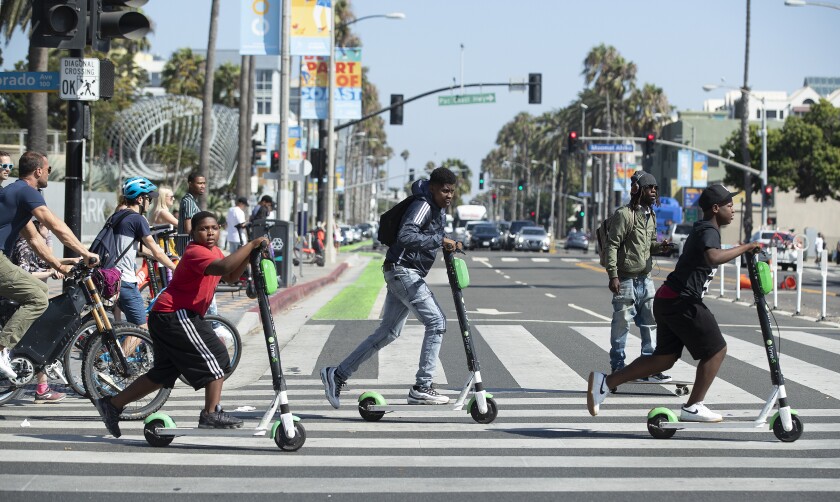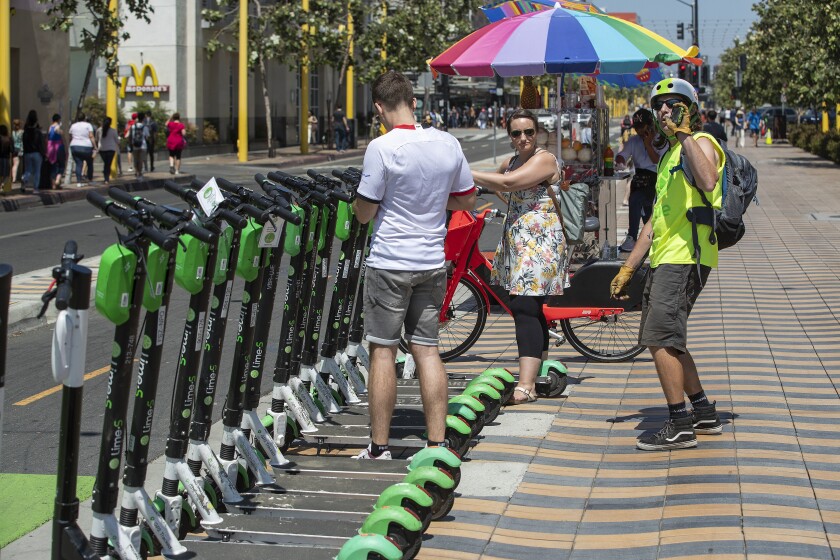Like scores of tourists who zip through Santa Monica on e-scooters every day, 21-year-old Elliot Stevenson had no idea there was a fence around the pier until he hit it.
“I was cruising down the hill and lost power,” the bewildered visitor from New Zealand said as he wheeled his just-rented Lime back toward Ocean Avenue on a recent Thursday afternoon. “[The motor] just stopped.”
12:51 PM, Sep. 17, 2019
Cities across California have followed Santa Monica’s lead in limiting the type and number of micro-mobility devices that move inside their borders, and how those vehicles are deployed. Now, many are testing the limits of a technology called geofencing to remotely enforce speed, parking restrictions and even dead zones.

People riding Lime scooters cross Ocean Boulevard at Colorado Avenue in Santa Monica. New and evolving geofence agreements between local cities and scooter companies have turned much of the Westside into an invisible obstacle course for riders. To help the perplexed, Lime has deployed “Lime Patrol” to parts of Santa Monica.
(Los Angeles Times)
“Even getting the companies to acknowledge that they were capable of geofencing was initially an issue,” said Cynthia Rose, director of Santa Monica Spoke, a bike and pedestrian advocacy group, and a member of the advisory committee that helped write the city’s scooter rules. “[Now] it’s written into their system. When the scooter approaches that area, they slow down and the motor no longer works.”
Eighteen months ago, that application seemed far-fetched. Today it’s so common, Lime keeps employees on hand to explain it, and to relocate the dozens of scooters abandoned in frustration when they stop.
“We have dedicated people to make sure we’re in compliance,” said Stephen Lee, an operations manager at the company. “The rules are changing a lot.”
Indeed, where fences are and what they do is constantly shifting, the product of agreements that, while often shaped by city ordinance, are designed and negotiated behind closed doors.
“These aren’t on the books,” said Juan Matute, deputy director of the UCLA Institute of Transportation Studies. “Given that what the companies are asked to do changes week to week, it can be hard for an individual to keep up with what’s permitted and what each company’s restrictions are.”

Paul Richardson, right, a member of the “Lime Patrol” for the scooter company Lime, warns a pair of riders about avoiding no-ride areas near the pier in Santa Monica, that if crossed will cause the scooters to power off.
(Los Angeles Times)
While cities around the world have begun to experiment with geofencing, those on L.A.’s Westside are on the cutting edge. But with so many companies operating with different rules in contiguous municipalities, the consequences are sometimes perplexing.
The city of Beverly Hills banned scooters in July 2018, but that ban feels different on a Lime than it does on a Jump or a Bird.
A Jump rider crossing Whitworth Drive at full throttle on Robertson Boulevard will find the scooter slowing to the Beverly Hills speed limit of 5 mph from the L.A. city limit of 15, while a Bird will stop completely at the border. A Lime can cruise through the city at 15 mph, though, like the others, it won’t be able to end the trip there. Those who abandon their still-active scooters inside city limits can face fines.
“We’ve had a hard time understanding the geofencing agreements and how they’re put in place,” said Eli Kaufman, executive director of the Los Angeles County Bicycle Coalition, which has begun to advocate for scooter riders. “There’s no didactic signage to let scooter riders know, there’s nothing on any of the micro-mobility websites that says this.”
Many companies do designate “red zones” on their service maps, but what actually happens to the scooter inside those boundaries often isn’t clear until a rider reaches one, experts said.
Signs along the beach bike path in Santa Monica warn riders e-vehicles are illegal, but not that they’ll stop. Other boundaries are still in flux, their rules and borders changing too fast to signpost.
“It’s evolving,” said Maurice Henderson, director of government partnerships at Bird. “Cities are trying to learn from each other. Some are more sophisticated about this conversation than others.”
Advocates say geofencing is more efficient than law enforcement at preventing accidents, and that it’s less punitive than the fines levied against those who ride on the sidewalk, an infraction that technology isn’t accurate enough to prevent.
The GPS on a scooter is what data scientists call “noisy,” a bit like a fuzzy radio signal. In ideal conditions, it can guess its location within about 16 feet. But that guess can jump moment to moment, adding a layer of frustration to barriers that, by design, appear suddenly out of thin air.
“The reality of consumer-level devices is that they’re going to be pretty noisy, and if you’re using [geofences] to control something without attempting to filter the noise, it’s not going to be safe,” said software engineer Morgan Herlocker of Shared Streets, a transportation data company. “We’ve got systems that are being built without a lot of testing and there’s no real safety regulations around a lot of this stuff.”
In addition to shaping geofencing rules, cities have also secured unprecedented rider trip data, a practice that troubles some digital privacy experts.
“A lot of people right now are like, I don’t care because I don’t like scooters, but it’s going to impact everyone eventually,” said Jamie Williams, a staff attorney with the Electronic Frontier Foundation. “What we’re seeing right now is cities trying to get data first and decide what to do with it later.”
Both data sharing and the current patchwork of scooter bans and regulations are the subject of state Assembly Bill 1112, which was proposed in February and is likely to be taken up next year. But whether the state steps in to regulate it, geofencing’s ephemeral urban architecture likely signals something more permanent about scooters in Los Angeles.
“We were thinking maybe this is just going to be a fad,” said Kaufman, the bike advocate. “But I think it’s pretty clear, the agreements they’re making with the cities are a sign these things are here to stay.”